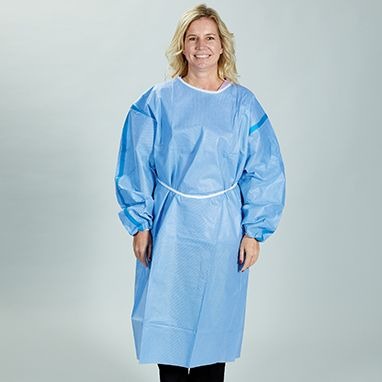Introduction
In the realm of healthcare and infection prevention, isolation gowns play a critical role in safeguarding both patients and healthcare workers. Among the various levels of protection, Level 2 isolation gowns are designed to provide a balance of comfort and barrier protection.
Let's delve into what Level 2 isolation gowns are, their significance, and how they contribute to maintaining safety in healthcare settings.
What are Level 2 Isolation Gowns?
Level 2 isolation gowns are protective garments designed to provide moderate barrier protection against fluids, pathogens, and contaminants. These gowns are classified based on their level of resistance to fluid penetration, with Level 2 offering a higher level of protection than Level 1 gowns but less than Level 3 gowns.
Level 2 isolation gowns are typically made from non-woven fabrics such as polypropylene and feature long sleeves, neck and waist ties, and varying degrees of fluid resistance.
The Importance of Level 2 Isolation Gowns
Moderate Barrier Protection
Level 2 isolation gowns are suitable for procedures and tasks with a moderate risk of exposure to infectious materials. They provide a higher level of protection than Level 1 gowns, making them ideal for use in settings where there is a greater potential for fluid splashes or sprays.
Comfort and Mobility
Despite offering increased protection, Level 2 isolation gowns are designed to prioritize comfort and mobility. The lightweight and breathable materials allow for ease of movement, ensuring that healthcare workers can perform their duties without feeling restricted or uncomfortable.
Cost-Effectiveness
Level 2 isolation gowns strike a balance between protection and cost-effectiveness. While they offer enhanced barrier protection compared to Level 1 gowns, they are typically more affordable than Level 3 gowns, making them a practical choice for healthcare facilities seeking to optimize their infection control practices without exceeding budget constraints.
Characteristics of Level 2 Isolation Gowns
Material
Level 2 isolation gowns are commonly made from non-woven fabrics such as polypropylene or a combination of polypropylene and polyethylene. These materials offer a balance of strength, durability, and fluid resistance.
Design
Level 2 isolation gowns feature long sleeves and full-body coverage to protect healthcare workers from exposure to fluids and contaminants. They may also include features such as thumb loops or knit cuffs to ensure a secure fit and prevent sleeves from riding up during use.
Fluid Resistance
Level 2 isolation gowns are designed to provide moderate fluid resistance, typically withstanding a minimum of 20-50 ml of fluid penetration over a specified period. This level of protection is suitable for procedures with a moderate risk of exposure to blood or bodily fluids.
Choosing the Right Isolation Gown Level
When selecting isolation gowns, it's essential to consider the level of protection required for the specific task or procedure. Factors to consider include the type of procedure, the risk of exposure to infectious materials, and any applicable safety guidelines or regulations.
While Level 2 isolation gowns offer moderate protection, higher-level gowns may be necessary for procedures with increased risk, such as surgeries or invasive medical interventions.
Proper Use and Disposal
Proper use and disposal of Level 2 isolation gowns are essential for maintaining safety and preventing the spread of infections. Here's a brief guide:
Proper Use
Donning the Gown
- Wash hands before putting on the gown.
- Slide arms into sleeves and tie securely.
- Ensure full coverage of torso and arms.
Performing Tasks Safely
- Be cautious to avoid tearing the gown.
- Minimize touching your face or adjusting the gown.
Removing the Gown
- Untie and remove the gown carefully, avoiding skin contact.
- Dispose of the gown promptly in an infectious waste container.
Proper Disposal
Segregating Waste
- Dispose of used gowns in designated infectious waste containers.
- Ensure containers are properly sealed and labeled.
Disposal Procedures
- Seal used gowns in plastic or biohazard bags before disposal.
- Follow facility-specific protocols for disposing of infectious waste.
Environmental Considerations
- Adhere to local regulations for proper disposal methods.
- Avoid disposing of gowns in regular trash or recycling bins.
Following these steps ensures effective use and disposal of Level 2 isolation gowns, contributing to a safer healthcare environment.
Conclusion
Level 2 isolation gowns are essential components of infection control protocols in healthcare settings. Offering moderate barrier protection against fluids and contaminants, these gowns strike a balance between comfort, mobility, and cost-effectiveness.
By understanding the characteristics and significance of Level 2 isolation gowns, healthcare facilities can make informed decisions to ensure the safety and well-being of both patients and healthcare workers.
As part of a comprehensive infection prevention strategy, Level 2 isolation gowns play a critical role in minimizing the risk of exposure to infectious materials and maintaining a safe and healthy environment for all.


No comments yet